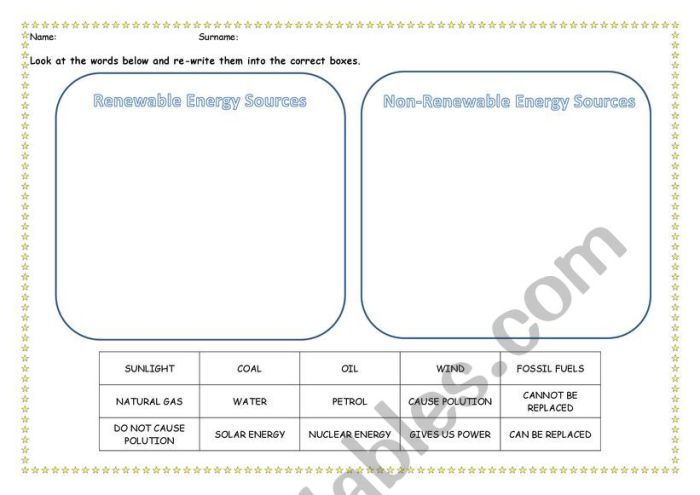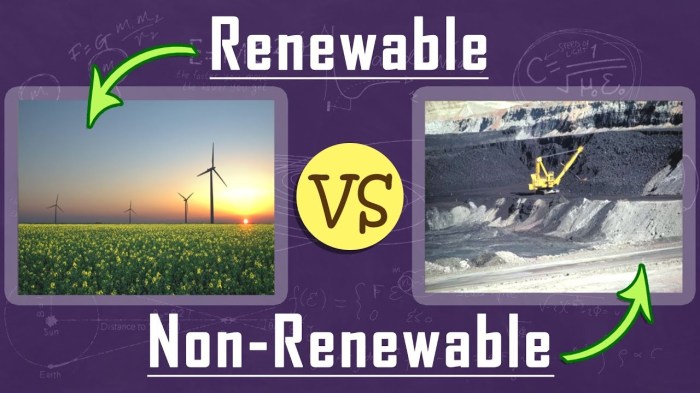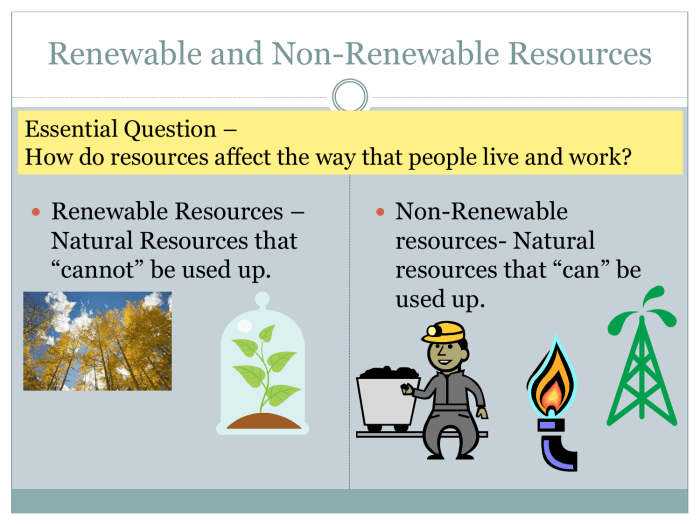Renewable non renewable resources worksheet – Beginning with the Renewable Non-Renewable Resources Worksheet, we embark on an educational journey to explore the fundamental concepts surrounding energy sources. This comprehensive resource provides a thorough understanding of the distinct characteristics, advantages, and disadvantages of renewable and non-renewable resources, empowering individuals to make informed decisions regarding energy consumption and conservation.
Throughout this worksheet, we will delve into the intricacies of renewable resources such as solar energy, wind energy, hydropower, biomass, and geothermal energy, highlighting their sustainable and environmentally friendly nature. Conversely, we will examine non-renewable resources like fossil fuels and nuclear energy, emphasizing their finite nature and potential contributions to pollution and climate change.
Introduction

Natural resources can be broadly classified into two categories: renewable and non-renewable resources. Renewable resources are those that can be replenished naturally over a relatively short period of time, while non-renewable resources are those that cannot be replenished or are replenished very slowly.
Examples of renewable resources include solar energy, wind energy, hydropower, biomass, and geothermal energy. Examples of non-renewable resources include fossil fuels (coal, oil, natural gas), nuclear energy, and minerals.
Conserving natural resources is crucial for sustainable development. It involves reducing consumption, using resources efficiently, and recycling and reusing materials. Conservation efforts can help mitigate environmental impacts, reduce dependence on finite resources, and ensure their availability for future generations.
Types of Renewable Resources

Solar Energy
Solar energy is derived from the sun’s radiation. It can be harnessed using solar panels or concentrated solar power systems to generate electricity or heat.
Wind Energy
Wind energy is generated by the movement of air. Wind turbines convert the kinetic energy of wind into electrical energy.
Hydropower
Hydropower is generated by the movement of water. Dams and turbines are used to capture the energy of flowing water and convert it into electricity.
Biomass
Biomass refers to organic matter from plants and animals. It can be used as a source of energy through combustion, anaerobic digestion, or gasification.
Geothermal Energy
Geothermal energy is derived from the heat of the Earth’s core. It can be used to generate electricity or heat buildings.
Types of Non-Renewable Resources: Renewable Non Renewable Resources Worksheet
Fossil Fuels
Fossil fuels are formed from the remains of ancient plants and animals that have been buried and subjected to heat and pressure over millions of years. Coal, oil, and natural gas are the most common fossil fuels.
Nuclear Energy
Nuclear energy is released through nuclear reactions, typically involving the fission of uranium or plutonium. Nuclear power plants generate electricity using nuclear energy.
Minerals
Minerals are naturally occurring inorganic substances with a specific chemical composition and crystal structure. They are essential for various industrial and technological processes.
Advantages and Disadvantages of Renewable Resources
Advantages:, Renewable non renewable resources worksheet
- Sustainable: Renewable resources are naturally replenished, ensuring their availability for future generations.
- Environmentally friendly: Renewable energy sources produce minimal greenhouse gases and other pollutants.
- Cost-effective: In the long run, renewable energy can be more cost-effective than non-renewable resources.
Disadvantages:
- Intermittent: Renewable energy sources such as solar and wind energy are intermittent, meaning they are not always available when needed.
- Require large-scale infrastructure: Renewable energy projects often require large-scale infrastructure, which can be expensive to build and maintain.
Advantages and Disadvantages of Non-Renewable Resources
Advantages:, Renewable non renewable resources worksheet
- Reliable: Non-renewable resources provide a reliable source of energy, as they are not affected by weather conditions or other factors.
- High-energy density: Non-renewable resources have a high-energy density, meaning they can store a lot of energy in a small volume.
Disadvantages:
- Finite: Non-renewable resources are finite, meaning they will eventually run out.
- Contribute to pollution and climate change: The combustion of fossil fuels releases greenhouse gases and other pollutants, contributing to air pollution and climate change.
Conservation of Natural Resources

Importance of Reducing Consumption
Reducing consumption is a crucial aspect of natural resource conservation. By using resources more efficiently and reducing waste, we can reduce the demand for non-renewable resources and prolong their availability.
Methods of Conserving Resources
There are various methods for conserving natural resources, including:
- Energy efficiency: Using energy-efficient appliances and practices can reduce energy consumption.
- Recycling: Recycling materials such as paper, plastic, and metal helps reduce waste and conserves resources.
- Reusing: Reusing items instead of discarding them can extend their lifespan and reduce waste.
Role of Government and Individuals
Both governments and individuals have a role to play in conservation efforts. Governments can implement policies and regulations to promote conservation, while individuals can make responsible choices in their daily lives.
FAQ Corner
What is the primary difference between renewable and non-renewable resources?
Renewable resources can be replenished naturally over a relatively short period, while non-renewable resources are finite and cannot be replaced once depleted.
Name three examples of renewable resources.
Solar energy, wind energy, and hydropower.
Why is it important to conserve natural resources?
Conservation helps reduce environmental degradation, mitigate climate change, and ensure the availability of resources for future generations.